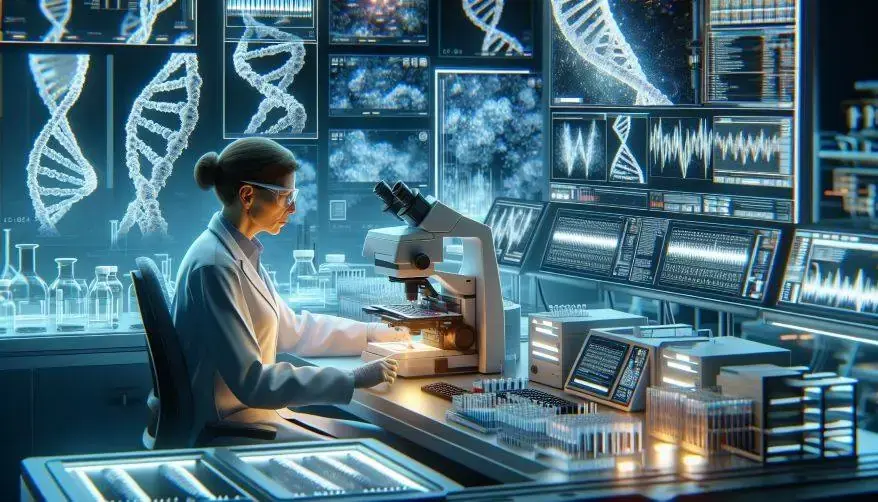Cyber-Biosecurity Threat: DNA Hacking in Next-Gen Sequencing
Next-Generation Sequencing (NGS) is revolutionizing healthcare and scientific research. It allows scientists to read DNA and RNA quickly and cheaply, unlocking insights into diseases, ancestry, and much more. However, this technological leap also brings significant cyber-biosecurity challenges. Think of it like this: NGS generates massive amounts of incredibly sensitive personal data. Protecting this data from hackers is crucial, and that’s where the exciting field of cyber-biosecurity comes in.
The Growing Threat Landscape: Protecting Your Genetic Information
Genomic data, the information encoded in our DNA, is extremely valuable. It holds the key to understanding diseases, developing personalized medicine, and tracing ancestry. Unfortunately, this value also makes it a prime target for cybercriminals. Moreover, the rise of AI tools adds another layer of complexity. Like, sophisticated AI chatbots could potentially be used to design and execute attacks. This means we need equally advanced defenses.
New Threats Emerge
Moreover, the study identifies several alarming emerging threats. These include:
- Synthetic DNA-encoded malware could be designed to attack biological systems.
- AI-driven manipulation of genomic data could be used to create false results.
- Identity tracing through re-identification techniques could expose your personal information through genetic data.
These aren’t just theoretical possibilities – they’re increasingly feasible threats.
The Vulnerabilities of Next-Gen Sequencing
NGS technology isn’t inherently insecure, but the way we handle the data it generates creates vulnerabilities. Data breaches at various stages of the NGS workflow—from data generation to analysis and storage—are possible. For example, insecure servers or databases can expose sensitive information. Hence, leading to identity theft or misuse of genetic predispositions. Consequently, strong security measures at every step are vital.
Real-World Examples of Cyberattacks
Numerous high-profile cyberattacks have already targeted healthcare and pharmaceutical organizations, highlighting the risks. The Synnovis attack on NHS England’s blood test provider. It exposed sensitive diagnostic data, underscoring the potential for malicious actors to combine this information with genetic data for devastating re-identification attacks. Furthermore, ransomware attacks on companies like Merck and Octapharma have disrupted operations and compromised patient data. Thus, proving that this is not a hypothetical threat but a very real one.
Building a Stronger Defense: Combating Cyber-Biosecurity Threats
Fortunately, the solution isn’t to abandon Next-Gen Sequencing (NGS). Instead, we need a multi-pronged approach to improve cyber-biosecurity. This involves strengthening data security protocols and educating professionals about the risks. Hence, fostering collaboration between cybersecurity and biotechnology experts. Furthermore, developing new technologies and strategies to protect genetic information is crucial.
The study also proposes actionable steps to strengthen cybersecurity in this area. Suggested measures include establishing secure sequencing protocols, utilizing encrypted storage options, and implementing AI-powered anomaly detection systems. These strategies aim to create a robust defense mechanism against potential breaches.
Navigating the Future: What’s Next?
To keep up with evolving threats in cyber-biosecurity, researchers advocate for a collaborative approach between biotechnology experts and cybersecurity professionals. This collaboration is crucial in developing strategies to safeguard genetic data against emerging risks associated with AI technologies and cyber threats. Maintaining the integrity of DNA analysis is paramount for advancements in personalized medicine and other vital fields like agriculture and forensic sciences.
A Call to Action!
You can make a difference! Stay curious about emerging technologies like Next-Gen Sequencing (NGS) while engaging in discussions around environmental factors affecting these innovations. By becoming active participants in addressing cybersecurity issues within your communities, you can advocate for well-informed policies. That protects individual privacy without hindering scientific progress.
Cyber-biosecurity is not just a technical issue; it’s a pivotal aspect of modern research shaping tomorrow’s innovations.
Reference
- Anjum, N., Alshahrani, H., Shaikh, A., Mahreen-Ul-Hassan, N., Kiran, M., Raz, S., & Alam, A. (2025). Cyber-Biosecurity Challenges in Next-Generation Sequencing: A Comprehensive analysis of emerging threat vectors. IEEE Access, 1. https://doi.org/10.1109/access.2025.3552069
Additionally, to stay updated with the latest developments in STEM research, visit ENTECH Online. Basically, this is our digital magazine for science, technology, engineering, and mathematics. Further, at ENTECH Online, you’ll find a wealth of information.






